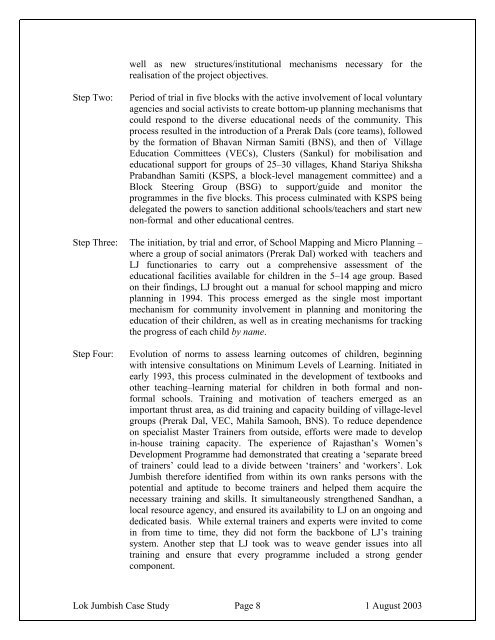LOK JUMBISH - RAJASTHAN
LOK JUMBISH - RAJASTHAN
LOK JUMBISH - RAJASTHAN
Create successful ePaper yourself
Turn your PDF publications into a flip-book with our unique Google optimized e-Paper software.
well as new structures/institutional mechanisms necessary for therealisation of the project objectives.Step Two:Period of trial in five blocks with the active involvement of local voluntaryagencies and social activists to create bottom-up planning mechanisms thatcould respond to the diverse educational needs of the community. Thisprocess resulted in the introduction of a Prerak Dals (core teams), followedby the formation of Bhavan Nirman Samiti (BNS), and then of VillageEducation Committees (VECs), Clusters (Sankul) for mobilisation andeducational support for groups of 25–30 villages, Khand Stariya ShikshaPrabandhan Samiti (KSPS, a block-level management committee) and aBlock Steering Group (BSG) to support/guide and monitor theprogrammes in the five blocks. This process culminated with KSPS beingdelegated the powers to sanction additional schools/teachers and start newnon-formal and other educational centres.Step Three: The initiation, by trial and error, of School Mapping and Micro Planning –where a group of social animators (Prerak Dal) worked with teachers andLJ functionaries to carry out a comprehensive assessment of theeducational facilities available for children in the 5–14 age group. Basedon their findings, LJ brought out a manual for school mapping and microplanning in 1994. This process emerged as the single most importantmechanism for community involvement in planning and monitoring theeducation of their children, as well as in creating mechanisms for trackingthe progress of each child Hy name.Step Four:Evolution of norms to assess learning outcomes of children, beginningwith intensive consultations on Minimum Levels of Learning. Initiated inearly 1993, this process culminated in the development of textbooks andother teaching–learning material for children in both formal and nonformalschools. Training and motivation of teachers emerged as animportant thrust area, as did training and capacity building of village-levelgroups (Prerak Dal, VEC, Mahila Samooh, BNS). To reduce dependenceon specialist Master Trainers from outside, efforts were made to developin-house training capacity. The experience of Rajasthan’s Women’sDevelopment Programme had demonstrated that creating a ‘separate breedof trainers’ could lead to a divide between ‘trainers’ and ‘workers’. LokJumbish therefore identified from within its own ranks persons with thepotential and aptitude to become trainers and helped them acquire thenecessary training and skills. It simultaneously strengthened Sandhan, alocal resource agency, and ensured its availability to LJ on an ongoing anddedicated basis. While external trainers and experts were invited to comein from time to time, they did not form the backbone of LJ’s trainingsystem. Another step that LJ took was to weave gender issues into alltraining and ensure that every programme included a strong gendercomponent.Lok Jumbish Case Study Page 8 1 August 2003












